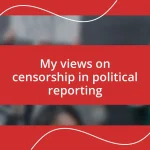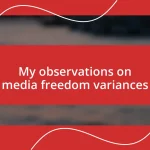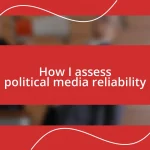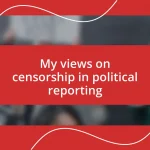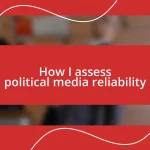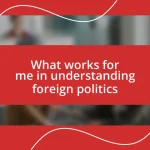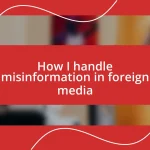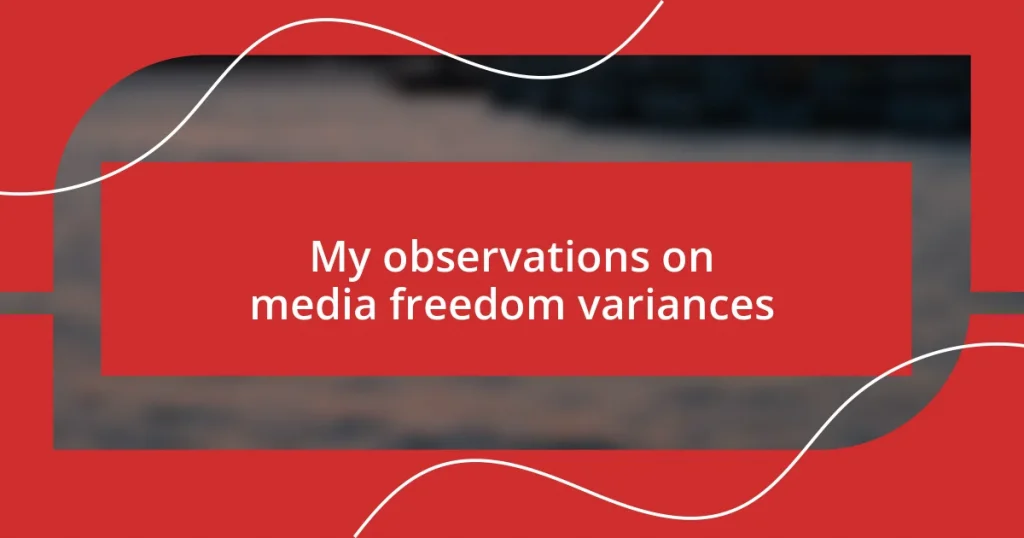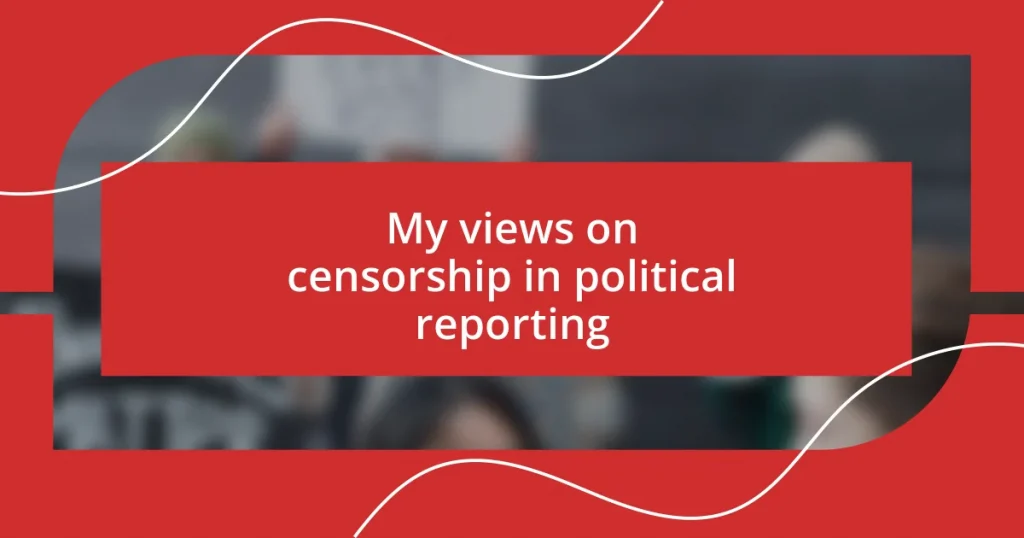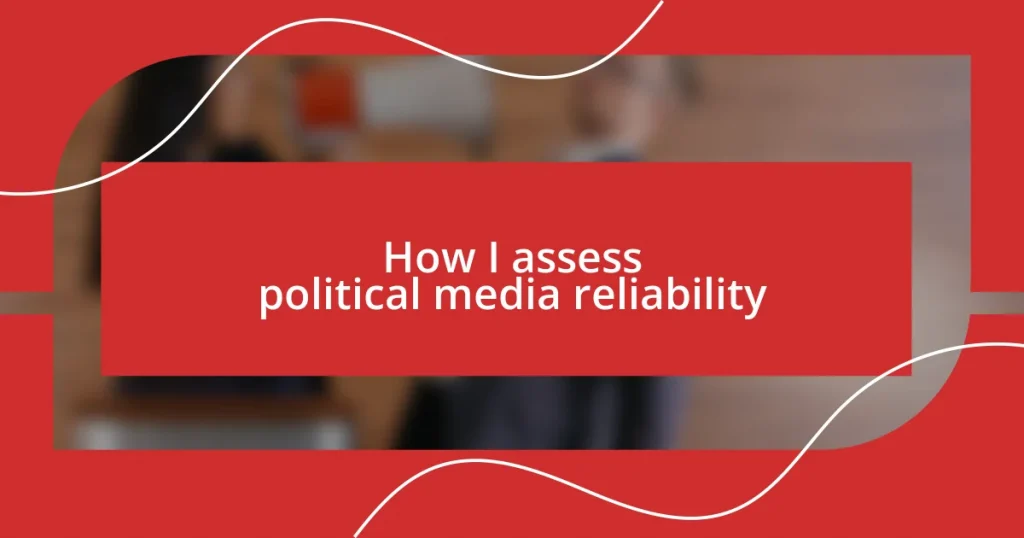Key takeaways:
- Media freedom is influenced by political climates, economic dependencies, public trust, technological changes, and legal frameworks, which vary markedly across different societies.
- Contrasting case studies from countries like China, Turkey, and Egypt highlight the severe impact of censorship and the risks faced by journalists striving to report the truth.
- Strengthening media independence can be achieved through community support for investigative journalism, robust legal protections for journalists, and collaboration among media organizations.
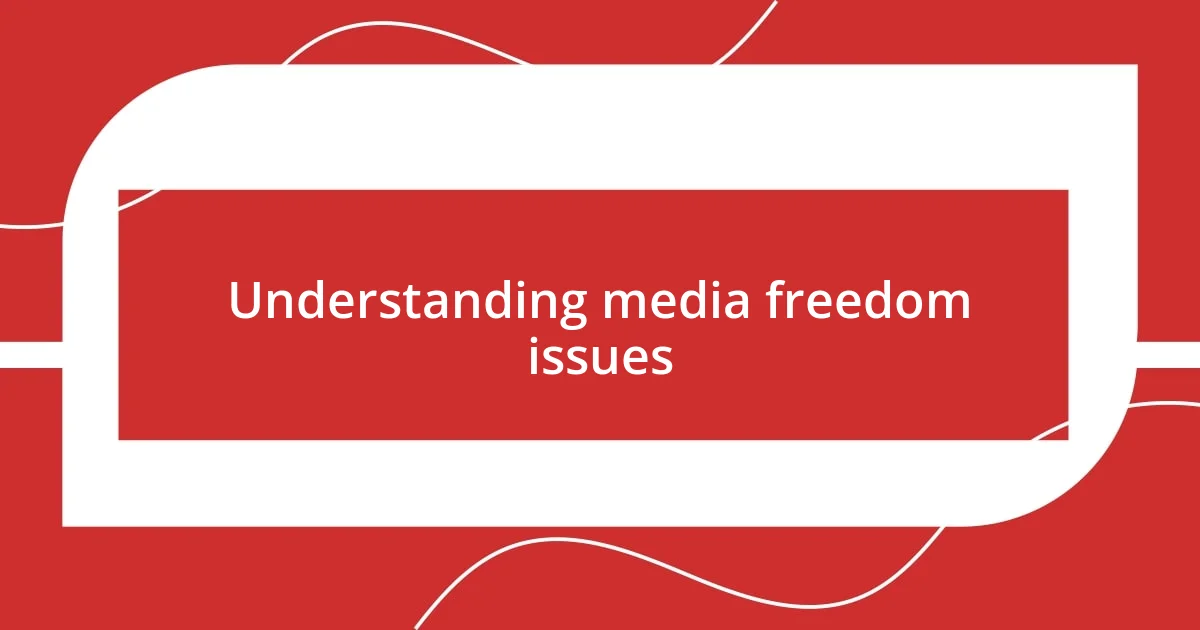
Understanding media freedom issues
Media freedom issues are often rooted in the context of a society’s political environment. I remember a time during my college years when I followed a local journalist who was detained for exposing governmental corruption. It struck me how even in what many deem to be “established democracies,” pressing for truth can come at a steep price. Isn’t it alarming that the very fabric of our societies can rattle at the sound of a honest report?
Another interesting observation is how media freedom tends to fluctuate with the rise and fall of public trust. When trust erodes, outlets may face pressure to conform to the narratives preferred by those in power. I’ve seen firsthand how this shapes public discourse; social media began as an open platform yet has shifted towards censorship. Are we losing our ability to discern fact from fiction when we allow fear to dictate what can be said?
Moreover, the global perspective reveals stark disparities in media freedom. Some nations enjoy vibrant press landscapes, while others stifle dissenting voices. I often find myself reflecting on these differences during international news coverage. It raises the question: how can we advocate for media freedom worldwide? The answer seems to lie in understanding that our local battles define the global narrative.
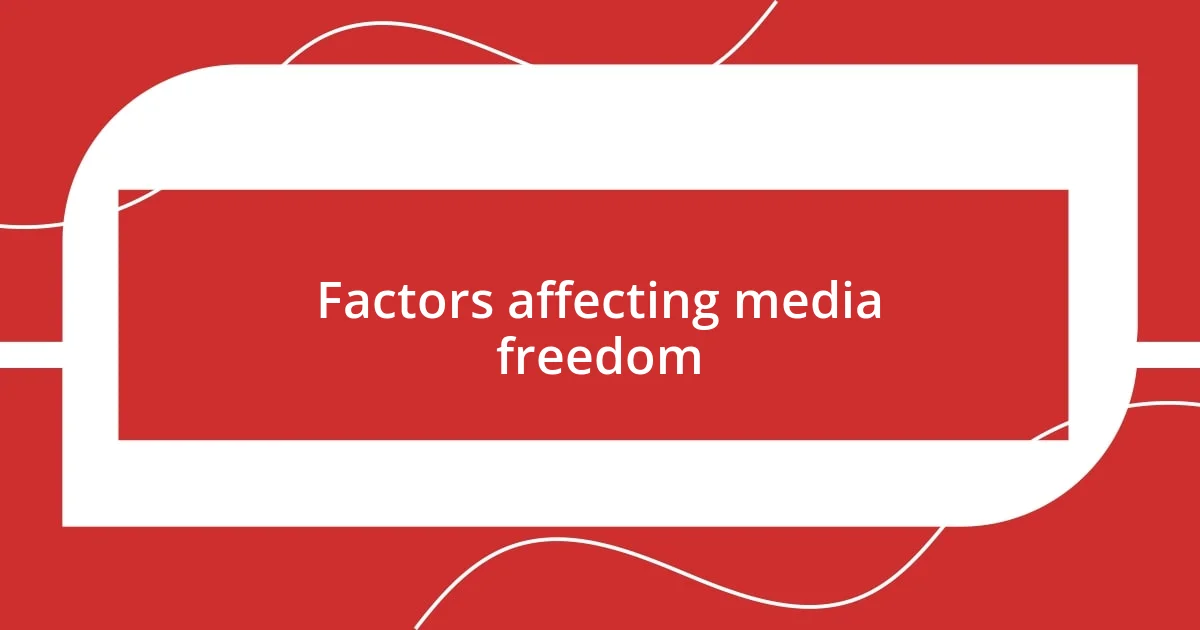
Factors affecting media freedom
The landscape of media freedom is affected by a myriad of factors that intertwine politics, economics, and societal norms. I recall attending a workshop where a journalist spoke about the realities in authoritarian regimes, where the fear of censorship looms. It made me ponder how economic dependencies, such as advertising revenue and government funding, can shape a news outlet’s integrity. The need for financial sustenance often forces media organizations to make tough choices, sometimes sacrificing truth for survival.
Several key factors influence media freedom:
- Political Climate: Authoritarian governments often impose strict controls, censoring dissent and manipulating narratives.
- Economic Pressures: Dependence on advertisers or government funding can lead to conflicts of interest, affecting editorial independence.
- Public Trust: A decline in trust can prompt media outlets to align with prevailing political ideologies, undermining their role as watchdogs.
- Technological Changes: Social media platforms can both empower diverse voices and facilitate censorship, shifting the way news is disseminated.
- Legal Framework: Laws regarding defamation, national security, and media ownership can dictate the level of freedom journalists enjoy.
These factors showcase how intricate the web of media freedom can be, reflecting the influence of societal values and institutional powers.
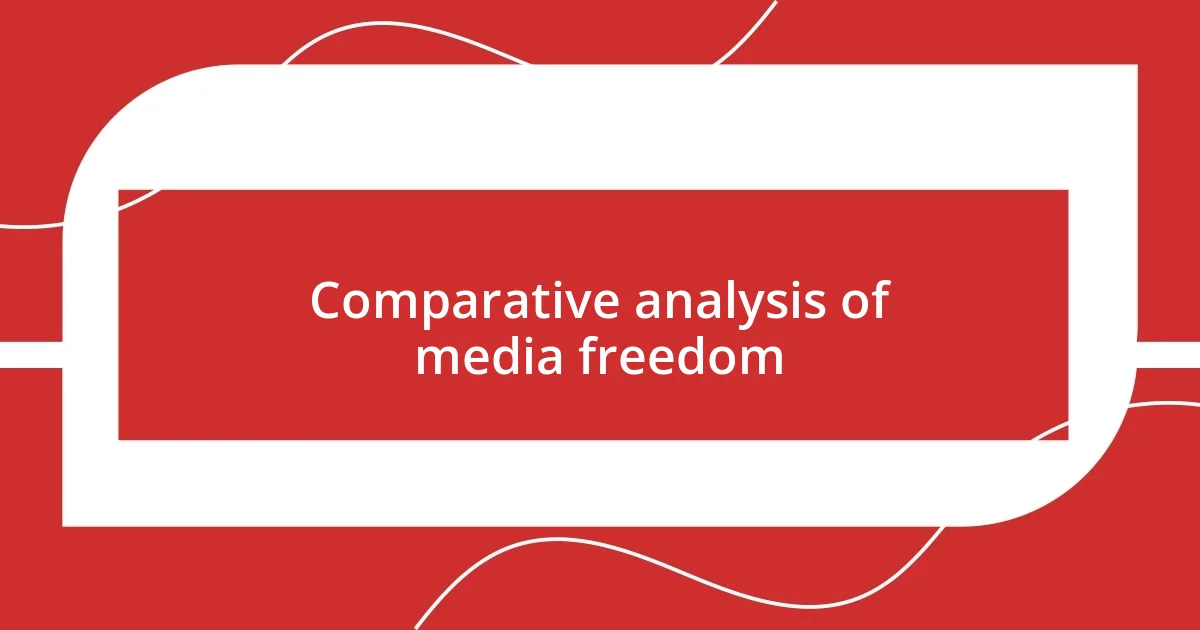
Comparative analysis of media freedom
When I explore the variances in media freedom across different countries, the contrasts can be quite startling. For instance, I remember reading about a journalist in Sweden who effortlessly exposed environmental issues without fear of retaliation, which made me think about my own experiences in less free societies. I’ve always felt that this level of freedom is essential for a thriving democracy—it empowers citizens and fosters accountability. Yet, how disheartening it is to witness journalists in countries like North Korea risk their lives simply by speaking the truth. The juxtaposition of these experiences reveals a stark reality: media freedom is as varied as the societies in which it exists.
Delving deeper, I’ve noticed that countries with more transparent political systems tend to provide a robust space for media. Take, for instance, the cooperative environment in Canada, where even grassroots media have a voice. I fondly recall being part of a community journalism project that sought to highlight local injustices; the support we received was empowering. In contrast, studying regimes that operate under heavy censorship made me appreciate the importance of democratic avenues for expression. It’s frustrating to think about how limitations on media can stifle innovation and public discourse.
Lastly, I find it crucial to acknowledge emerging trends that affect media freedom globally. As technology evolves, I’ve seen traditional media struggle to adapt, often leading to sensationalism as they vie for audience attention. Reflecting on my journey through various media landscapes, I’ve become increasingly aware of how vital it is for us to challenge narratives and demand accountability. The evolution of media freedom isn’t just a national issue; it feels deeply personal and essential for the collective enlightenment of society.
| Country | Media Freedom Status |
|---|---|
| Sweden | High – Strong legal protections and free press culture |
| Canada | Moderate – Generally free but facing challenges like media consolidation |
| North Korea | Very Low – Strict government control and censorship |
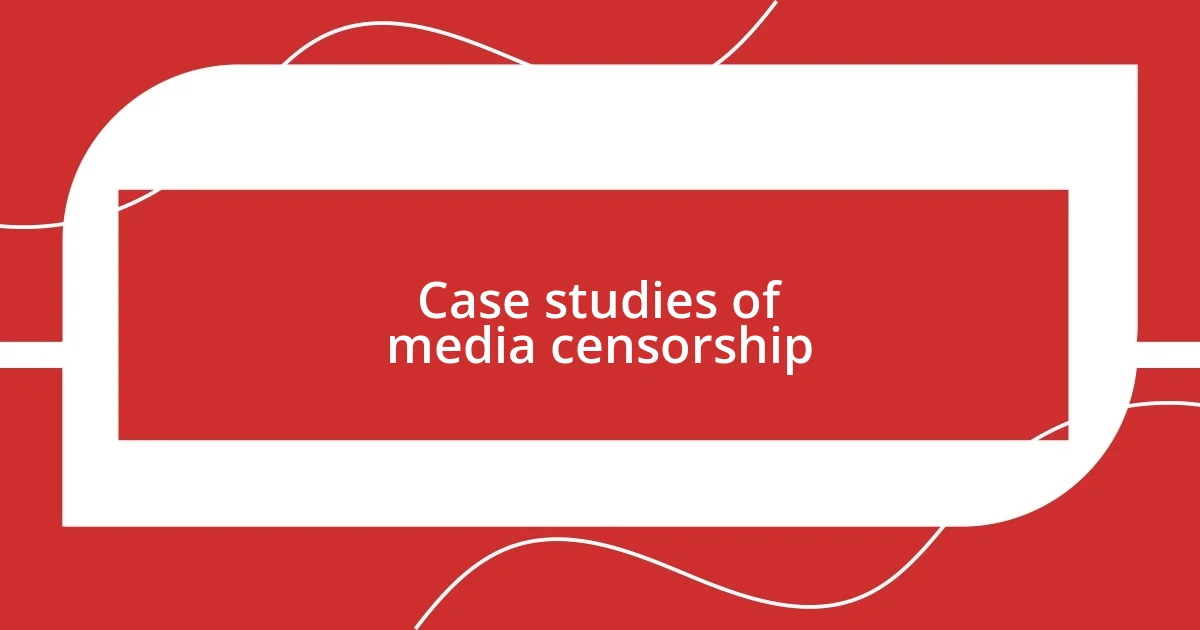
Case studies of media censorship
When I think about media censorship, two contrasting examples always come to mind: China and Turkey. In China, the Great Firewall serves as a powerful tool that not only blocks foreign media but impacts domestic outlets too. It’s always struck me how journalists must navigate a minefield of regulations, shaping their stories to avoid severe consequences. Just imagine the weight of that pressure, where the narrative you passionately believe in can be silenced overnight.
Then there’s the case of Turkey, where the government has cracked down on dissenting voices, especially post-2016 coup attempt. I remember watching reports of journalists being jailed for merely doing their jobs. It raises the question: when even basic reporting can lead to imprisonment, what does that say about freedom of expression? I find it disheartening, especially knowing that countries once seen as bastions of free speech can deteriorate so quickly.
An eye-opening story I encountered was in Egypt, where journalists covering protests faced immense hostility. The tension in the air was palpable; it reminded me of times I’ve felt pressure to self-censor out of fear of backlash. The courage it takes for journalists in such environments leaves me in awe. It truly makes me wonder: at what point do we, as a society, stand up for those who dare to uphold the truth, even in the face of overwhelming odds?
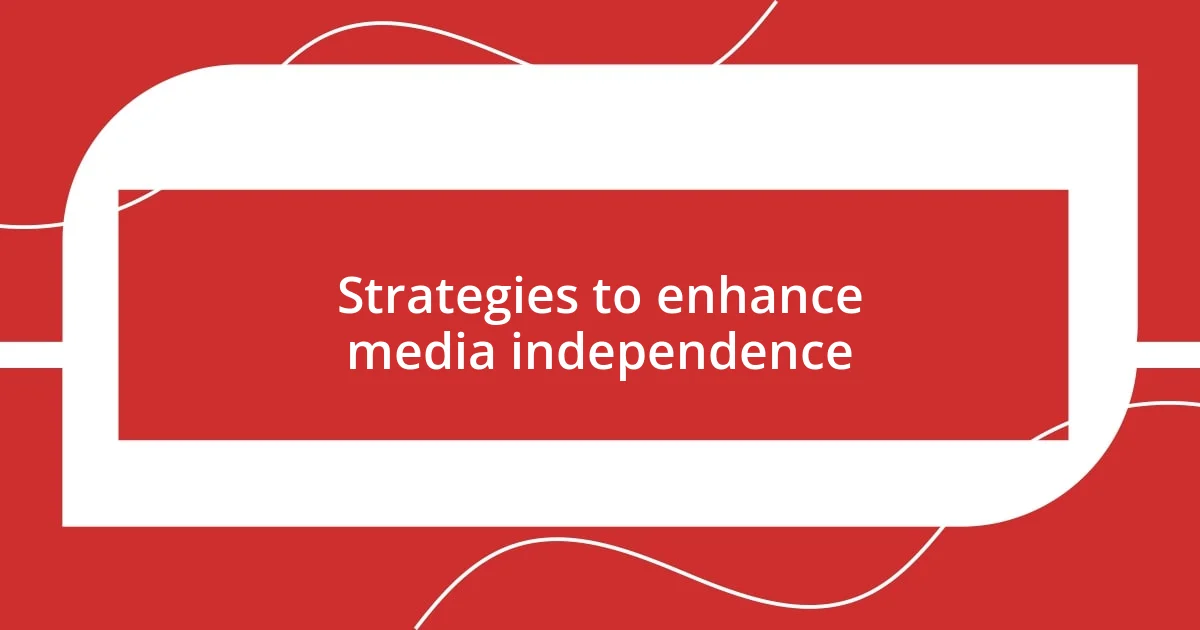
Strategies to enhance media independence
To enhance media independence, one powerful strategy is fostering a culture of support for investigative journalism. I remember a local community initiative where citizens contributed to a fund specifically for investigative reporting. It was remarkable to see how this not only empowered journalists but also increased public engagement. When communities take an active role in supporting media, it creates a buffer against external pressures.
Another effective approach is the implementation of stronger legal protections for journalists. I think back to a workshop I attended, where legal experts educated budding journalists on their rights. The relief on their faces when they realized they had tools to fight for their freedom of expression was palpable. Legal frameworks that protect journalists can uplift an entire media landscape, encouraging more fearless reporting.
Lastly, collaboration between media outlets can help bolster independence. In a world where many voices get drowned out, I’ve seen how partnerships between different media organizations can amplify stories that need to be told. For instance, I once observed a coalition of independent newsrooms come together to cover a critical environmental issue, sharing resources and expertise. This united front not only elevated their work but also illustrated that independence isn’t just an individual pursuit; it thrives through shared commitment.
